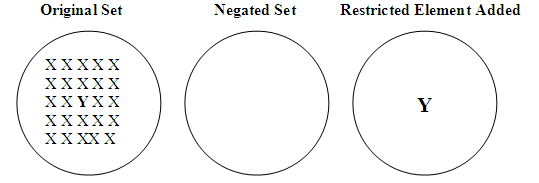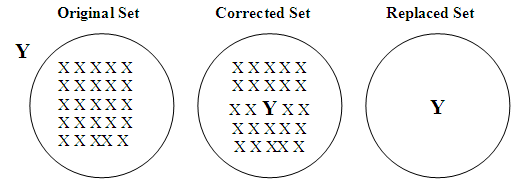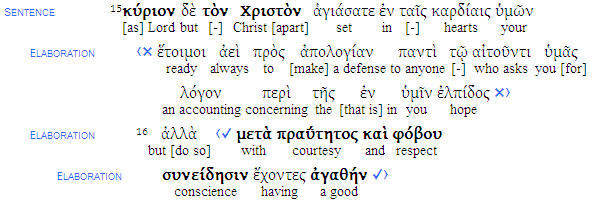Here is the third part in a series of posts on the difference between ἀλλά and εἰ μή that began here. Seumas won all the money in the world (plus the camper) for figuring out the difference between these two conjunctions, a brain teaser in the second post. Be sure to read the other posts if you have not already, including the comments.
Recall that the particle ἀλλά can be used to replace or correct something whether it has been negated or not. Rick’s paper focuses exclusively on the use of ἀλλά in non-negative contexts. What about εἰ μή? Can it be used in non-negative contexts? The answer in most every case is “no”. But there is one exception (pun intended): rhetorical questions. This apparent exception confused me even more than the original problem, since it seemed to break with the expected pattern of negation. Then I realized that even though the rhetorical questions are technically positive, they expected a negative answer where εἰ μή was used . In other words, the expected answer to the question is nothing or no one.
Here is an example of a rhetorical question that is followed by an excepted element that was a member of the original set. It is taken from the scene where Jesus forgives the sins of the paralytic before healing him. The Pharisees’ question leads Jesus to respond by asking which is easier, to heal or to forgive sins. Here is the Pharisees’ response to Jesus forgiving the man’s sins.
Mark 2:7

The question ‘who’ in v. 7b creates a set of potential candidates that can forgive sins. The implicit answer is that no one can forgive sins, creating the same effect as the negated clauses or pronouns. The question is also rhetorical in that the speaker provides the answer to his own question. The interrogative pronoun also serves as a forward-pointing reference attracting attention to an intended target (cf. Section 3.3.1 of the Discourse Grammar sample here). In this usage with the excepted element, the forward-pointing reference has a secondary effect of creating a counterpoint that highlights the more important point that follows in the restrictive clause. Other examples of this usage are found in 1 John 2:22 and 5:5.
So in reality, εἰ μή appears to only be used when the excepted element is part of the original negated set, whether explicitly negated or implicitly (at least, this is my working theory). The same seems to hold true in English with the differentiation between “rather/instead” and “except.”
This is where I need your help. I am asking you to test these ideas with other languages you are familiar with. According to Google analytics, there should be a good variety reading this from around the world. Does the principle of the excepted element being part of the negated set hold true? See if what I am thinking holds up.
I doubt this claim is original to me, I expect I just reinvented the wheel by virtue of not doing enough research to find the citation.
To summarize, here is my claim: Although there are several contrastive or adversative particles, the key to distinguishing ἀλλὰ from εἰ μή is the relation of replacement to the original set of items that is replaced/corrected.
In the case of εἰ μή, the excepted element that replaces what precedes was a potential member of the negated set. Look back at the example from Mark 6:4-5: a conceptual set of data are established either by use of a negated or an interrogative clause. The negation serves to remove all possible candidates from the data set, essentially wiping the slate clean by negation (e.g. no one can do X=X is not able to be done by anyone). The interrogative asks a question whose answer is expected to be negative (e.g. Who can do this? Cf. Mark 2:7) In both cases, this protasis has the effect of predicating a set of items that is completely removed from consideration. This is where the exceptive/restrictive apodosis comes in. One member from the original set that was negated is presented as an exception. The illustration below attempts to capture graphically what is happening conceptually (suggestions about improvements are welcome).

Only after reading the apodosis does the reader realize that the totality of the initial protasis is not the complete story. There is one item singled out for consideration. Think of it as sweeping everything off a table onto the floor, and then adding back the one item you were interested in on to the table. The item that is placed back on the table stands out. This is a great strategy for explaining grammar to waitresses at restaurants, to spread your love of grammar. I am sure they would see value in the exercise, go for it!
In the case of ἀλλὰ, the correcting member is not a member of the original set; it is a new element. The original set may or may not be negated. The new element is either added to the original set to correct it (as in the middle circle), or alternatively it replaces the original set (and in the right circle below).

As an example of a correction using ἀλλὰ in a non-negative context, consider 1 Peter 3:15-16, taken from the LDGNT:

The proposition of v. 15 holds true, but a caveat is added in v. 16 to correct or complete the thought. The challenge to always be ready to make a defense is not a blank check to do whatever it takes, to humiliate someone or treat them disrespectfully. This potential thought is nipped in the bud by the thought introduced by ἀλλὰ .
Think about the counterparts to ἀλλὰ and εἰ μή in the language that you are familiar with. Think about the membership of what is replaced to the original set. Does this principle hold true in other languages? I would be interested to learn if these principles are observed elsewhere in exceptive constructions.
Isn’t grammar wonderful?

Yes, grammar is wonderful, and your blog is helping me enjoy it more!
I will consider the Latin, and get back to you!
Hi, I recently came across your website after someone posted it on the Bible translation forum. These posts on /alla/ and /ei mh/ have been interesting. I work in a language in Papua New Guinea called Gumawana. I checked my data and it seems to work like you suggest for the Greek. We use /go sem/ ‘but’ to correct and replace a constituent that was not in the original set. The spacer (from Stephen Levinsohn and Robert Dooley’s work) /go/ is used for a constituent which was part of the original set. So your example from Mark 6 would read in Gumawana: God’s prophets receive honor in all places /go/ in their own villages and from their own people and from their own homes they have no honor.” Furthermore, I have discovered that clauses that follow /go/ are foregrounded with respect to what preceded.
Your example from Peter and making a defense for the faith would require our conjunction /go sem/. However, I need to check that because typically we would have to supply the implied negation “don’t do it with an attitude of disrespect /go sem/ do so …” It may be that they can do it without putting in the implied negated clause. But it does seem to operate as you have suggested for the Greek. Thank you for posting this because I had only understood the Gumawana particles in terms of negation alone.
When is your grammar due to be published?
Clif
Clif,
Thanks for the comment and data. I have made a similar claim regarding foregrounding of the information following EI MH, and annotated these constituents in the LDGNT as “Emphasis-other” to distinguish them from fronted focal constituents, i.e. Dik’s P2 position or Lambrecht’s marked focus.
The grammar heads off to a copy-editor in the next couple weeks. I have no idea when it will actually come out. I will continue blogging on the concepts.